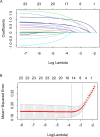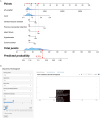Risk factors analysis and prediction model establishment of acute kidney injury after heart valve replacement in patients with normal renal function
- PMID: 39995967
- PMCID: PMC11847868
- DOI: 10.3389/fcvm.2025.1422870
Risk factors analysis and prediction model establishment of acute kidney injury after heart valve replacement in patients with normal renal function
Abstract
Background: The study aimed to develop a risk prediction model through screening preoperative risk factors for acute kidney injury (AKI) after heart valve replacement in patients with normal renal function.
Methods: A total of 608 patients with normal renal function who underwent heart valve replacement from November 2013 to June 2022 were analyzed retrospectively. The Lasso regression was used to preliminarily screen potential risk factors, which were entered into the multivariable logistic regression analysis to identify preoperative independent risk factors for postoperative AKI. Based on the results, a risk prediction model was developed, and traditional and dynamic nomograms were constructed. The risk prediction model was evaluated using receiver operating characteristic (ROC), calibration curve, and decision curve analysis (DCA).
Results: 220 patients (36.2%) developed AKI after surgery. Current smoker, hypertension, heart failure, previous myocardial infarction, cerebrovascular disease, CysC, and NT-proBNP were selected as independent risk factors for AKI. A risk prediction model, a traditional and a dynamic nomogram were developed based on the above factors. The area under the curve (AUC) of the ROC for predicting the risk of postoperative AKI was 0.803 (95% CI 0.769-0.836), with sensitivity and specificity of 84.9% and 63.4%, respectively. The calibration curve slope was close to 1, and the DCA showed that the model produced better clinical benefits when the probability threshold was set at 10%-82%.
Conclusions: We developed a preoperative risk prediction model for AKI after heart valve replacement in patients with normal renal function, which demonstrated satisfactory discrimination and calibration.
Keywords: acute kidney injury; dynamic nomogram; heart valve replacement; normal renal function; prediction model.
© 2025 Huang, Sun, Song, Wang, Liu and Zhang.
Conflict of interest statement
The authors declare that the research was conducted in the absence of any commercial or financial relationships that could be construed as a potential conflict of interest.
Figures




References
LinkOut - more resources
Full Text Sources
Research Materials

